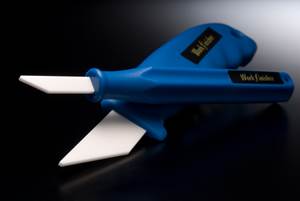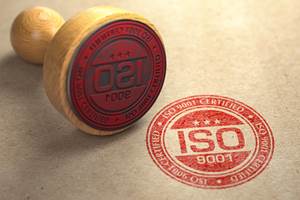Keeping Up with ISO: Sort, Set, Shine, Standardize, Sustain
The 5S system is a working tool for ISO 9001:2015 that was developed to help mangers and work personnel systematically achieve greater organization, standardization, efficiency and safety in the workplace.
Organization in the industrial workplace is rarely improved through work-flow and physical redesign alone. This is where the 5S system (sort, set in order, shine, standardize, sustain) comes into play. 5S is a working tool for ISO 9001:2015 that was developed to help mangers and work personnel systematically achieve greater organization, standardization, efficiency and safety in the workplace.
A main benefit of 5S implementation is the creation of new sources to track down and correct workplace inefficiencies. Shop issues are brought to light and goals are set to improve all-around shopfloor efficiency. Before-and-after record keeping, including photographs of workplace conditions and records of each employee’s routine tasks and task times, will help evaluate the success of the 5S program in your shop.
Getting started with 5S requires the creation of an internal committee of 5S team leaders. This group is assigned to manage this system from “sort” through “sustain.” Depending on shop size, the committee may be as small as a single individual or comprised of many 5S team leaders that come from a variety of management, supervisory and shopfloor levels, actively promoting 5S from its inception.
Once a shop has developed a formal plan for implementation, the system can move forward. All employees are encouraged to actively participate in 5S. This requires proper training on how implementation will improve their workplaces. It should also refine each individual’s role and describe the benefits of 5S.
Five-Step Implementation
Each of the five steps plays an integral role in helping facilities successfully implement and sustain the 5S system. Once each step has been implemented, the 5S system is designed to function indefinitely. To achieve this, managers and shop employees must embrace the system by integrating it into their daily work routines. Keep in mind, reaching the final step in 5S signifies the completion of implementation, but never ends the overall system of organization. 5S should continue to cycle through previous steps, as appropriate, so a shop remains organized for maximum efficiency.
1. Sort. The goal is to filter through all workplace inventories and tools so needless items, redundancies and hazards can be sorted out of the workplace. Throw away rubbish and unrelated materials. Reduce workplace clutter. Dispose of unused items.
2. Set in order. This step is dedicated to helping a shop find permanent storage locations for every item and visually identifying their locations. Set things in proper place for quick retrieval and storage.
3. Shine. This refers to the critical cleaning and basic maintenance duties employees incorporate into their daily routines. Once in place, shine becomes an invaluable step in this system. Reductions in clutter and debris around equipment and workplaces allows for improved work area safety and personnel efficiency. Clean the workplace. Every one should be a janitor.
4. Standardize. This is the backbone of the 5S system. This is the step where previously implemented steps become more permanent fixtures in the workplace. It also helps create uniformity in the workforce and seamlessly integrates 5S duties into the daily routines of employees from the shop floor to management. Uniformity in a shop’s labeling and signage breeds efficiency. Employees recognize what they are communicating quicker and more clearly. The 5S standard color code is as follows:
• Green—safety
• Blue—equipment and inventory
• Yellow or orange—standards
• Red—defects and fire
• White—total process management
• Gray—racks and storage
5. Sustain. The final step is dedicated to sustaining the system indefinitely. This means each previous step must now become embedded into the shop’s daily operations so the system can be sustained permanently. Employees should be expected to complete assigned 5S duties routinely and with little supervision. Signage, displaying scheduled 5s system duties and directions, should be properly displayed in strategic locations so confusion is eliminated. 5S education will now be integrated into existing new-worker training programs. This will help all employees immediately understand their roles and help maintain uniformity.
Although 5S should now begin to function more independently, sustaining the system will require assertive management. 5S team leaders must set examples by following through on scheduled work-area inspections, without exception. Calendars identifying dates and times of all 5S meetings should be provided to 5S team leaders and all facility managers. This dedication to sustaining the system will be the catalyst for continued 5S success and inspire employees to embrace the 5S system.
Related Content
Treatment and Disposal of Used Metalworking Fluids
With greater emphasis on fluid longevity and fluid recycling, it is important to remember that water-based metalworking fluids are “consumable” and have a finite life.
Read MoreCeramic Deburring, Deflashing Tools Take Into Consideration Difficult Materials, Operator Safety
Boride Engineered Abrasives introduces its new mold polishing equipment, the Work Finisher Tool, which is lightweight, long lasting, won’t rust and is safer and easier to use.
Read MoreHow To Get Buy-In from Your Team for ISO 9001
Here are four tips for getting your team on board once you’ve decided to become ISO 9001 certified.
Read MoreU.S. Economic Fundamentals Impacting Moldmaking
The economy continues to downshift, capping growth in moldmaking.
Read MoreRead Next
Reasons to Use Fiber Lasers for Mold Cleaning
Fiber lasers offer a simplicity, speed, control and portability, minimizing mold cleaning risks.
Read MoreHow to Use Continuing Education to Remain Competitive in Moldmaking
Continued training helps moldmakers make tooling decisions and properly use the latest cutting tool to efficiently machine high-quality molds.
Read MoreAre You a Moldmaker Considering 3D Printing? Consider the 3D Printing Workshop at NPE2024
Presentations will cover 3D printing for mold tooling, material innovation, product development, bridge production and full-scale, high-volume additive manufacturing.
Read More

























